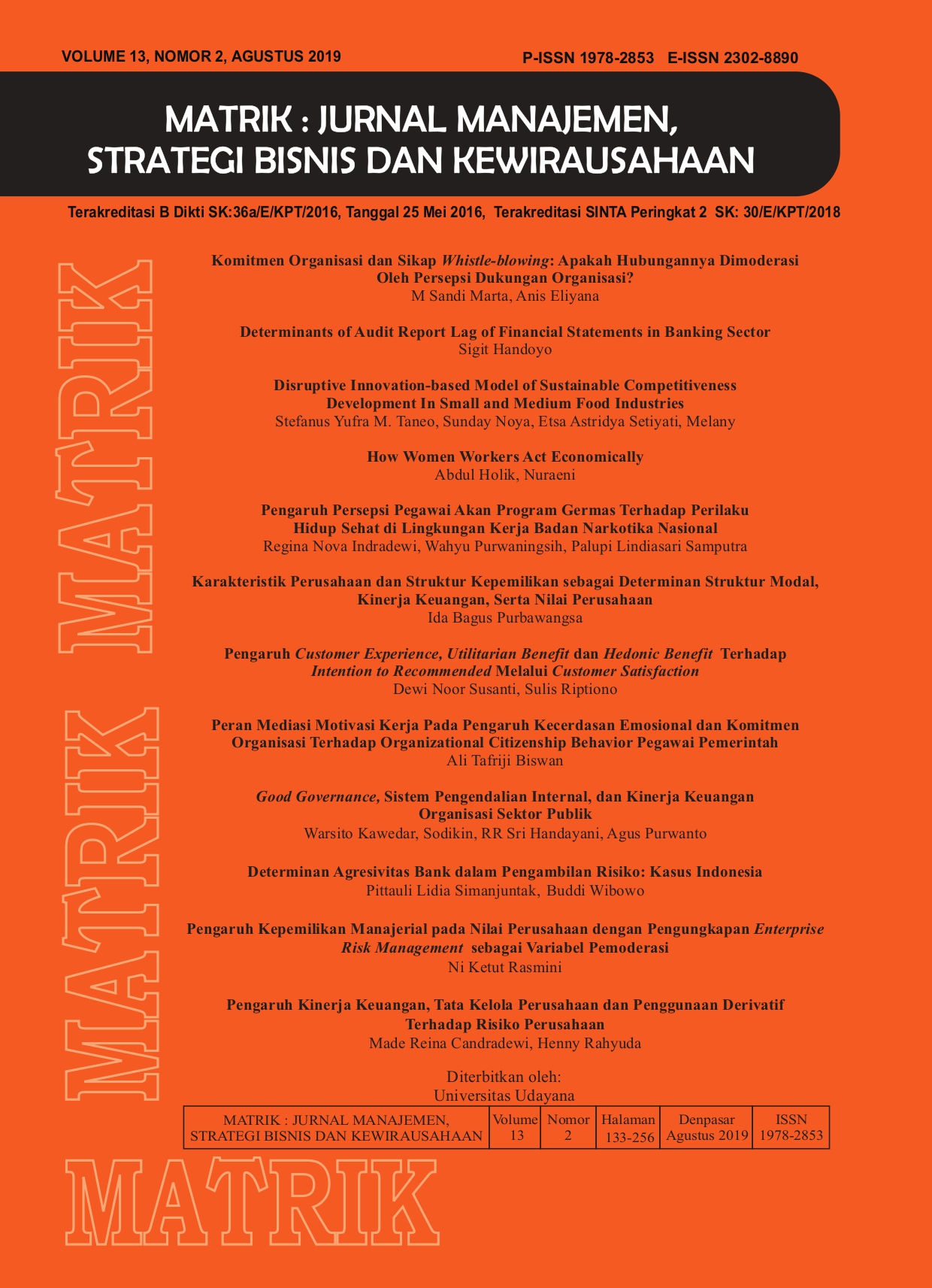Determinan Agresivitas Bank Dalam Pengambilan Risiko: Kasus Indonesia
Abstract
This study is aimed to identify and analyze the important factors that affect the aggressiveness of bank risk taking in Indonesia. Referring to previous research in several countries, market interest rate, bank capitalization, profitability, bank asset size, bank income diversification and bank efficiency are the influential factors that drives bank risk taking behavior. This study uses Jakarta Interbank Offered Rate, Indonesia Government Bonds Yield, Bank Indonesia Rate, and Bank Level Lending Rate as market interest rate measures. Level of aggressiveness in taking risk is measured by using the amount of risky assets owned by banks and bank credit risk. Credit risk is measured by using loan loss reserves. The results show that Bank Indonesia Rate is the most interest rate affecting bank aggressiveness in risk taking as measured by risk assets and measured by loan loss reserves. Efficiency, income diversification, and profitability are significant factor that affect bank risk taking.
Downloads
References
Acharya, V., Engle, R., Pierret, D., 2014. Testing macroprudential stress tests: the risk of regulatory risk weights. Journal of Monetary Economics. 65(1): 36–53.
Acharya, V.V., Rajan, R.G., 2011. Sovereign Debt, Government Myopia, and theFinancial Sector. Federal Reserve Bank of St Louis, St. Louis.
Ashcraft, A.B. (2006). New evidence on the lending channel. Journal of Money, Credit, and Banking 38: 751–776.
Attinasi, M.-G., Checherita, C., Nickel, C., 2010. What explains the surge in Euroarea sovereign spreads during the financial crisis of 2007–09? Public Finance Management. 10: 595–645.
Barth, J.R., Caprio JR., G., Levine, R., 2013. Bank regulation and supervision in 180 countries from 1999 to 2011. Journal Financial Economics Policy 5:111–219.
Barry, T.A., Lepetit, L., Tarazi, A., 2011. Ownership structure and risk in publiclyheld and privately owned banks. Journal of Banking and Finance 35: 1327–1340.
Bhagat, S., Bolton, B., Lu, J., 2015. Size, leverage, and risk-taking of financial institutions. Journal of Banking and Finance 59: 520–537.
Birge, J.R., Júdice, P., 2013. Long-term bank balance sheet management: estimationand simulation of risk-factors. Journal of Banking and Finance 37: 4711–4720.
Brissimis, S.N., Delis, M.D. (2009). Bank heterogeneity and monetary policy transmission. European Central Bank Working Paper, No. 1233.
Bushman, R.M., Williams, C.D., 2012. Accounting discretion, loan loss provisioning,and discipline of Banks’ risk-taking. Journal of Accounting and Economics. 54: 1–18.
Craig, B.R., Dinger, V., 2013. Deposit market competition, wholesale funding, and bank risk. Journal of Banking and Finance 37: 3605–3622.
Dell’Ariccia, G., Laeven, L., Marquez, R., 2014. Real interest rates, leverage, and bankrisk-taking. Journal of Economics Theory 149: 65–99.
Delis, M.D., Kouretas, G.P. (2011). Interest Rates and Bank Risk-Taking. Journal of Banking & Finance 35: 840-855.
Demirgüç-Kunt, A., Detragiache, E., Tressel, T. (2008). Banking on the principles: compliance with Basel core principles and bank soundness. Journal of Financial Intermediation 17: 511–542.
Foos, D., Norden, Lars., Weber, M. (2010). Loan Growth and Riskiness of Banks. Journal of Banking and Finance 34, 2929-2940.
Hadad, MD., Agusman, Monroeb, Gary.S., Gasbarroc, D. (2011). Market discipline, financial crisis, and regulatory changes: Evidence from Indonesian banks. Journal of Banking and Finance 35: 1552-1526.
Hakenes, H., Schnabel, I., 2011. Bank size and risk-taking under Basel II. Journal of Banking and Finance 35: 1436–1449.
Houston, J.F., Lin, C., Lin, P., Ma, Y., 2010. Creditor rights, information sharing, andbank risk taking. Journal of Financial Economics 96, 485–512.
Ioannidou, V.P., Ongena, S., Peydro, J.L. (2009). Monetary policy, risk-taking and pricing: Evidence from a quasi-natural experiment. CentER Discussion Paper No. 2009-31S.
Jimenez, G., Ongena, S., Peydro, J.L., Saurina, J. (2008). Hazardous times for monetary policy: what do twenty-three million bank loans say about the effects of monetary policy on credit risk? CEPR Discussion Paper No. 6514.
Jin, J.Y., Kanagaretnam, K., Lobo, G.J., Mathieu, R., 2013. Impact of FDICIA internalcontrols on bank risk taking. Journal of Banking and Finance 37: 614–624.
Laeven, L., Levine, R. (2009). Bank governance, regulation and risk taking. Journal of Financial Economics 93: 259–275.
Makri, V., Papadatos, K., 2014. How accounting information and macroeconomic environment determine credit risk? Evidence from Greece. International Journal of Economics Science and Applied Research. 7: 129–143
Mistrulli, P.E., 2011. Assessing financial contagion in the interbank market: maximum entropy versus observed interbank lending patterns. Journal Banking and Finance 35: 1114–1127.
Molnár, K., Santoro, S., 2014. Optimal monetary policy when agents are learning. European Economics Review. 66, 39–62.
Upper, C., 2011. Simulation methods to assess the danger of contagion in interbankmarkets. Journal of Financial Stability 7: 111–125.
Valencia, F., 2014. Monetary policy, bank leverage, and financial stability. Journal of Economics and Dynamic Control 47: 20–38.
 This work is licensed under a Creative Commons Attribution-ShareAlike 4.0 International License.
This work is licensed under a Creative Commons Attribution-ShareAlike 4.0 International License.

















